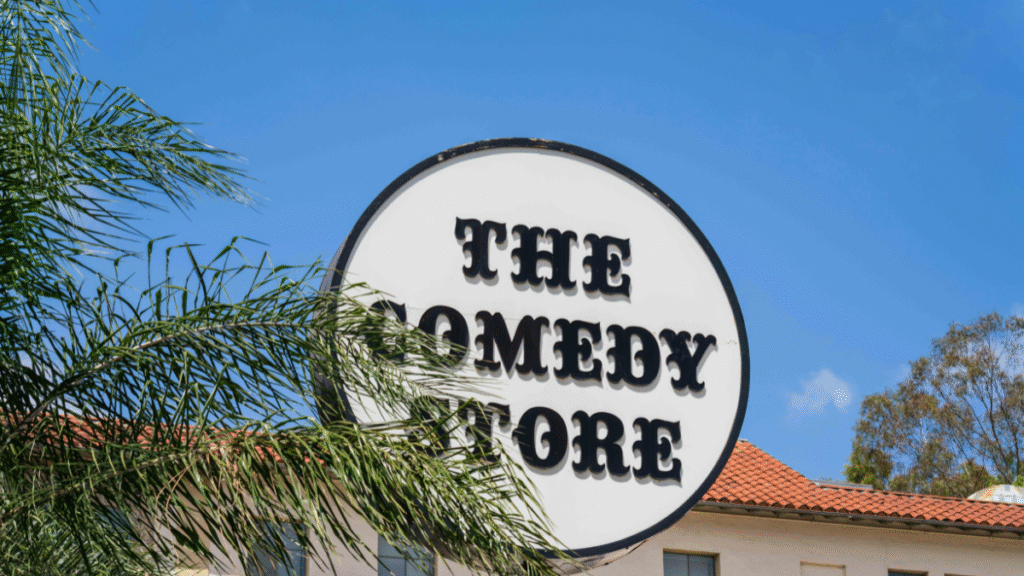Last Updated on September 6, 2025

When you think of a night out filled with laughter, chances are you’re picturing a comedy club—dim lights, a brick wall backdrop, and a comedian with a mic spinning stories that make the room erupt. But how did we get here?
The journey of the American comedy club is as unpredictable as a late-night open mic. From smoky vaudeville theaters to Netflix specials being workshopped on tiny stages, comedy clubs have shaped—and been shaped by—American culture. Here’s how it all unfolded.
🎭 Before Comedy Clubs: Vaudeville and Nightclub Roots (1800s–1940s)
Before dedicated comedy clubs existed, comedians were just one act among many in the vaudeville circuit. From the late 1800s through the early 1900s, theaters featured variety shows packed with dancers, musicians, magicians, and comics.
As vaudeville declined in the 1930s and ‘40s, stand-up shifted to lounges and nightclubs. These weren’t comedy-specific venues yet—comedians shared stages with jazz bands and cabaret acts—but they laid the foundation for stand-up comedy as a solo art form.
🎙️ The Rise of Stand-Up and the First Comedy Venues (1950s–1960s)
The 1950s saw the emergence of more personal and socially aware comedy. Lenny Bruce changed the game by delivering raw, often controversial material that reflected the cultural unrest of the time.
Clubs like The Hungry i in San Francisco and small performance spaces in Greenwich Village began treating comedy as a headlining act. While still not full-on “comedy clubs,” they gave stand-up comedy a dedicated spotlight.
🎤 The Real Comedy Club Boom: 1970s
The 1970s marked the true birth of the modern comedy club. In 1972, The Comedy Store opened in Los Angeles and quickly became a launchpad for legends like Robin Williams, Richard Pryor, and David Letterman.
Other influential venues followed, including:
- The Improv – Founded by Budd Friedman, expanding from NYC to Hollywood.
- Catch a Rising Star – A New York staple that helped launch Jerry Seinfeld and Chris Rock.
These clubs introduced a structured set format (emcee, feature, headliner) and became central to a comedian’s career growth.
📺 Stand-Up Goes Mainstream: The 1980s Comedy Boom
By the 1980s, comedy clubs exploded across America. Fueled by cable TV and stand-up specials, clubs opened in every major city—and many smaller ones too. TV shows like An Evening at the Improv brought the club scene into millions of homes.
Chains like The Funny Bone and The Punchline expanded rapidly. Comedy became a hot industry, with clubs acting as scouting grounds for TV and film deals.
But by the decade’s end, oversaturation and formulaic content began wearing thin on audiences.
💥 The Crash: 1990s Burnout
The early 1990s saw the comedy club bubble burst. Many venues shut down, unable to sustain interest. The mainstream shifted away from stand-up, and the club scene suffered.
Yet this downturn sparked creativity. The alternative comedy movement took hold in underground spaces like:
- Luna Lounge – New York City
- UnCabaret – Los Angeles
Comics like Janeane Garofalo, Marc Maron, and Patton Oswalt embraced more intimate, narrative-driven comedy that moved away from conventional club material.
📈 Reinvention and Resurgence: 2000s–2010s
In the 2000s, comedy clubs started bouncing back—this time with help from the internet. Platforms like YouTube, Twitter, and podcasting let comedians grow loyal fanbases outside of TV or club owners.
Surviving clubs doubled down on quality and community. Standouts like:
- The Comedy Cellar – New York City
- Gotham Comedy Club – New York City
- Laugh Factory – Los Angeles and Chicago
…continued to draw top talent and packed rooms. Meanwhile, local scenes in cities like Austin, Denver, and Portland began to thrive.
Importantly, this period also saw greater diversity on stage. More women, LGBTQ+ performers, and comedians of color began getting the spotlight they long deserved.
🤹 Comedy Clubs Today: Balancing Tradition and Innovation
In 2025, comedy clubs are adapting once again. Many now host live-streamed events, record podcasts, or double as content creation hubs. Others focus on cultivating hyper-local comedy communities.
And though digital content is king, live performance still holds magic. There’s nothing like a room full of people laughing together—unfiltered, immediate, and real.
🎬 Final Thoughts: Why Comedy Clubs Still Matter
From vaudeville to viral videos, the comedy club has remained a vital space for creative risk-taking. It’s where voices are sharpened, careers are launched, and culture is critiqued—one joke at a time.
So if you’re ever looking for a night out with substance, energy, and maybe a little chaos, find your local comedy club. You might just witness the next great comic—and get a story worth retelling.
Comedy Club Venues is the premier online destination for fans of live comedy who are looking looking for the best comedy clubs in the U.S.

